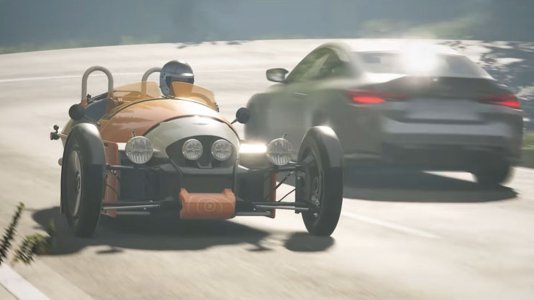Reik Major
Premium
Before answering your tricky question I like to clarify something about the number plates in the braking zone, because I think Kurt and you miscounted them so it could become confusing.
Davids "slow-mo-vid" proves that there are 3 number plates counting up from the corner as follows: 100 - 150 - 200 (between 150 and 200 a white line crosses the road).
As a reference my braking point in attacking mode is ~ 20 m after the second number plate (~ 130 m). In normal stint mode it is at the second number plate (~ 150 m) and in caution mode, following few cars it could move back close to the third number plate (~ 170 m to 190 m).
So from what I see in Davids slow-mo-vid stopping at ~ 25 seconds you were still on full throttle at ~ 160 m. Ok, the replay has a short delay so I assume you braked at ~ 170 m (reminding ~ 150 m is my usual braking point).
In my eyes that's ok but not leaving much room if the guys in front have some trouble and/or brake very early too, because of giving themselfs enough safety margin to the car in front.
Well when I follow a pack I keep a safe distance and wait until things have settled and positions have sorted. It depends on the exact situation but so to speak you're right. You can't really "race" in such a situation and sometimes better go into "wait and observe" mode.
I take my last Sepang race as an example. I started from 11th and followed a few fighting packs through the first stint. In the most situations I waited until the front runners made a mistake or the faster one had overtaken the slower one so it was my turn to attack the slower one then. Into that process of "waiting" I even lost a position sometimes but finally it paid of.
From my observation of Davids vid you aren't doing it carefull enough. In my eyes you could have braked even at ~ 180 - 200 m, approaching to the cars in front by coasting in the last part of the braking zone. In addition this would have given you a better opportunity to "drive arround" David on the outside (maybe touching grass) as you weren't braking hard anymore and therefore able to turn.
Btw, at such places with long straights followed by a slow corner there's no need to catch up with the front pack in the beginning of the corner. If the guys in front have a fight they'll most likely have a worse entry, a worse corner speed and a worse exit speed. So if you do the "brake-early-then-coast-approach" you maybe able to take that corner perfectly. So you won't close up with them in the beginning of the corner (dangerous) but close after the exit. Now they take notice of you being involved in the fight too and maybe now it's your turn to outbrake one of them. If they took the slow corner well instead and you can't get close enough after the corner then the same procedure should repeat.
Note: That particular place is the most tricky one in this matter as we have lowest possible downforce and highest possible speed there. So 20 meters could mean nothing if one makes a tiny mistake, be it a slight lane change on the one side or a slightly too small safety margin added to the usual braking point on the other side.
PS: This long post (sorry for that) is not meant to transfere some more blame to you Valter. I only want to express how many factors need to be considered when racing and that understanding them and making the right decisions can sometimes be a very tough or nearly impossible task. (I'm certain I still haven't learned and experienced everything myself about racing yet
I only want to express how many factors need to be considered when racing and that understanding them and making the right decisions can sometimes be a very tough or nearly impossible task. (I'm certain I still haven't learned and experienced everything myself about racing yet  )
)
Davids "slow-mo-vid" proves that there are 3 number plates counting up from the corner as follows: 100 - 150 - 200 (between 150 and 200 a white line crosses the road).
As a reference my braking point in attacking mode is ~ 20 m after the second number plate (~ 130 m). In normal stint mode it is at the second number plate (~ 150 m) and in caution mode, following few cars it could move back close to the third number plate (~ 170 m to 190 m).
So from what I see in Davids slow-mo-vid stopping at ~ 25 seconds you were still on full throttle at ~ 160 m. Ok, the replay has a short delay so I assume you braked at ~ 170 m (reminding ~ 150 m is my usual braking point).
In my eyes that's ok but not leaving much room if the guys in front have some trouble and/or brake very early too, because of giving themselfs enough safety margin to the car in front.
[...]Isn't it impossible to race if you can't exploit the situation and make a careful attempt to come up level with the car ahead, [...]? [...] If there are more then one car close in front should you go in to a "only watch from far behind" mode so you don't interfere in their racing?
Well when I follow a pack I keep a safe distance and wait until things have settled and positions have sorted. It depends on the exact situation but so to speak you're right. You can't really "race" in such a situation and sometimes better go into "wait and observe" mode.
I take my last Sepang race as an example. I started from 11th and followed a few fighting packs through the first stint. In the most situations I waited until the front runners made a mistake or the faster one had overtaken the slower one so it was my turn to attack the slower one then. Into that process of "waiting" I even lost a position sometimes but finally it paid of.
[...]Isn't it impossible to race if you can't exploit the situation and make a careful attempt to come up level with the car ahead, as he has slowed down very early.[...]
From my observation of Davids vid you aren't doing it carefull enough. In my eyes you could have braked even at ~ 180 - 200 m, approaching to the cars in front by coasting in the last part of the braking zone. In addition this would have given you a better opportunity to "drive arround" David on the outside (maybe touching grass) as you weren't braking hard anymore and therefore able to turn.
Btw, at such places with long straights followed by a slow corner there's no need to catch up with the front pack in the beginning of the corner. If the guys in front have a fight they'll most likely have a worse entry, a worse corner speed and a worse exit speed. So if you do the "brake-early-then-coast-approach" you maybe able to take that corner perfectly. So you won't close up with them in the beginning of the corner (dangerous) but close after the exit. Now they take notice of you being involved in the fight too and maybe now it's your turn to outbrake one of them. If they took the slow corner well instead and you can't get close enough after the corner then the same procedure should repeat.
Note: That particular place is the most tricky one in this matter as we have lowest possible downforce and highest possible speed there. So 20 meters could mean nothing if one makes a tiny mistake, be it a slight lane change on the one side or a slightly too small safety margin added to the usual braking point on the other side.
PS: This long post (sorry for that) is not meant to transfere some more blame to you Valter.










